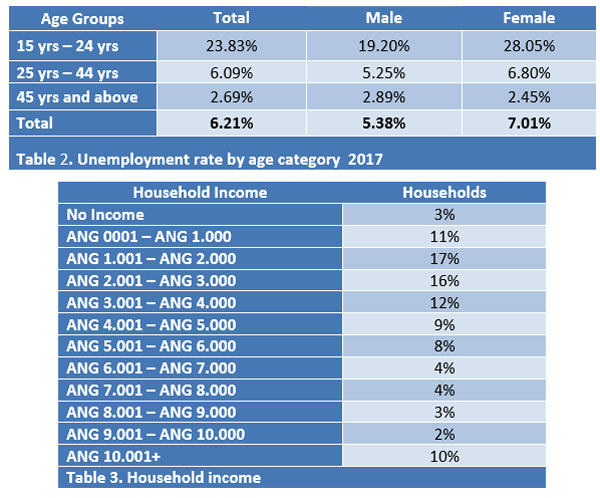PHILIPSBURG:--- The Department of Statistics (STAT) released today main results of it's 2017 Labour Force Survey.
The Labour Force Survey (LFS) is a sample survey among households with the broad aim to measure the recent developments of the labour market.
The topics covered in the 2017 Labour Force Survey are: ‐ Demographics: gender, age, country of birth, nationality, marital status, years on island, migration intentions, relationship to head of household ‐ Education: highest level of education completed, diplomas, trainings ‐ Employment: employed status, main job, additional jobs, business ownership, economic status, contract details, membership to labour union, work benefits ‐ Unemployed: length of unemployment, reason for unemployment ‐ Income
2
Data collection for this year’s LFS started January 16th and lasted about 7 weeks until the first week of March. A total of 1,200 households were visited, and the response rate was 76%.
The following are the key concepts and official definitions used in the computing of employment statistics, and some of the key findings of the survey.
Definition of employment: Employment refers to all persons aged 15 years and over who worked for pay any time during the reference week or who worked without pay for at least one hour in a family-operated business. Persons who were temporarily absent from their regular jobs because of vacation, illness, inclement weather, or similar reasons are also included.
Definition of unemployment: Unemployment refers to persons aged 15 years and over who did not work or have a job from which they were temporarily absent during the reference week, but were actively looking for work in the four weeks prior to the survey week, and were able and willing to work. Persons who did not look for work because they were on layoff or waiting to start a new job within the following 30 days are also classified as unemployed.
Definition of economically inactive: Economically Inactive refers to persons 15 years and over who were neither employed nor unemployed and who have not actively sought work in the last four weeks and/or are not available to start work in the next two weeks. This includes persons who are retired.
Labour Force (also called the economically active population): The number of employed and unemployed added together.
Unemployment rate: The number of unemployed divided by the labour force multiplied by 100.
Participation rate: The labour force divided by the total population multiplied by 100. It indicates what proportion of the total population is economically active.

It is important to note that the: 2007 Labour Force Survey was conducted in March 2007 (High Season) 2009 Labour Force Survey was conducted in June 2009 (Low Season) 2011 figures are based on the Population Census conducted in April 2011 (High Season) 2013 Labour Force Survey was conducted in June 2013 (Low Season) 2017 Labour Force Survey was conducted in February 2017 (High Season).
The next scheduled Labour Force Survey will take place in the low season so that alternate comparisons can be made. Any direct comparisons between figures across the years should take this into consideration.












